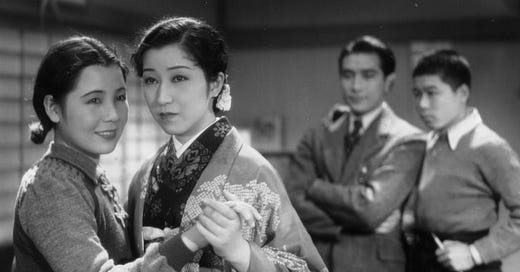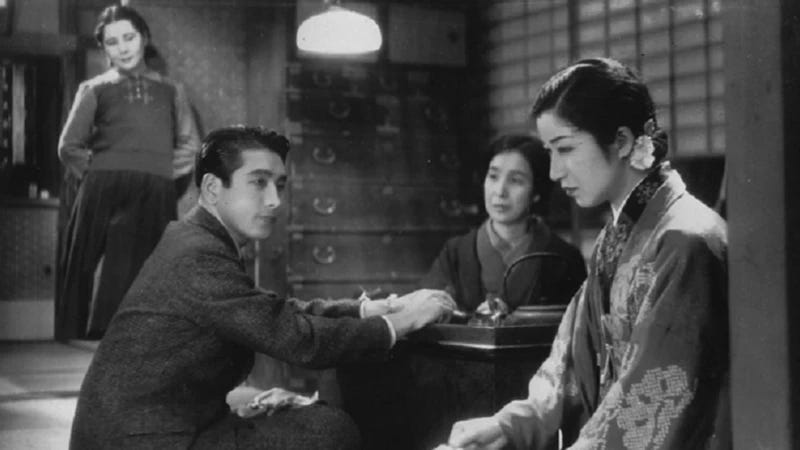The Tokyo of Mikio Naruse's 1937 A Woman's Sorrow’s is westernized and dollish. The women who inhabit the space are coded by dress and the men are their meticulously groomed and astonishingly handsome ornaments. Houses are sterile and untouched despite being adorned with evidence of family life. Hallways and empty streets do not stand innocently but obfuscate intentionality. No phone rings unanswered. This is not the domestic everyday despite how much it might pretend to be
In this tranquility, Hiroko (Takakio Irie) is in crisis. She is a lower class woman who has decided to marry the wealthy More (Ho Kitazawa) to support her mother and brother. She moves in with her new husband's family and begins to be treated like a servant by her youngest sister-in-law (Reiko Minakami). The rest of the family follows suit; a treatment that intensifies when her older sister-in-law, Yoko (Ranko Sawa), returns home after having run away to marry a lower class man. Although barely a few years apart in age, changing society has created a canyon between her and the modern young women. Not conservative enough to be content as a traditional housewife, nor carefree enough to have the affair she desires, nor liberated enough to impress the young women around her, Hiroko is alone. Naruse offers Yoko as Hiroko's antithesis: a self-interested, immature young woman happy to cast her family aside when she falls in love and her love aside when she runs out of money. Yet, Yoko is not liberated. One burdened by overwhelming consideration, the other by inconsideration, both women are uncomfortable. A middle-ground has to be found.
Hiroko's ugly step-sisters-in-law are perfect foils. Sawa and Minakami's mean-spirited liveliness is a welcome break from Hiroko's calm disarray. Sawa's troubled expressions play out the horrible sacrifice of selfishness to greater consciousness. You covet close-ups of her aside glances. At Sawa's side is the facetious and cheeky Minakami who performs uniform-clad battlement at Hiroko's servitude - whilst never failing to use her to her fullest. Their perkiness is mellowed by Irie, who's unmoving, made-up brow is full of uncertainty and care. Whatever you are searching for, one of these three women will answer.
A Woman's Sorrows recently played at Japan Society as part of 'Mikio Naruse: The World Betrays Us': the Japanese auteur's first New York program in 20 years. Speaking about the two-parted event which has spanned over 2 months, film programmer Alexander Fee comments on how post-pandemic film culture has moved away from 'large-scale in-depth retrospectives' and the significance of undertaking this program at Japan Society.
'For Japan Society Film, in particular, which heralded critical recognition of now-established canonical filmmakers like Teshigahara, Naruse, and Ozu at a time when they were hardly known-serving as an important critical resource to bring better understanding of Japanese film culture to Americans -programs like Naruse serve as an almost generational introduction to filmmakers that remain inaccessible, whether through lack of distribution or other means. The last time there was a Naruse retrospective of this scale, I was in middle school, so doing a program like this helps introduce younger audiences to filmmakers beyond just what they can find on streaming'.
A Woman's Sorrows unfolds in the crevices. When we talk about excellent costuming, we often mean dramatic fabric creations that spill from the confines of narrative. In A Woman's Sorrows clothes are mundane. They don't impress or overreach. As Hiroko rustles underneath layers of uncomfortable, stiff, and elaborate traditional costume, her situation becomes obvious. No one else in the film dresses like she does. She simultaneously towers over her family and shrinks behind her clothes. Her younger relatives dress much more accessibly. This is not just because their slouched jumpers and hanging skirts are more familiar to the modern dresser but because these women are in symbiosis with what they wear. The relationship between women and clothes is often misconstrued on screen—reduced to lame moments of feminism where a plucky lady-turned-pirate complains about her suffocating corset. Naruse's ultimate genius in costuming is that Hiroko chose to put these awkward clothes on. Complicity is at stake here. Ironically, her own sense of self continues to fight to be preserved. Speaking on some of the challenges of organizing such a retrospective, Alexander comments on the rarity of these kindred spirits:
‘Much of the work we do is organizing programs on films that remind undistributed outside of Japan, which means we work directly with Japanese companies and archives to coordinate these programs. Japanese companies operate very differently than American distributors, so a lot of it is also about knowing how to navigate those spaces, and how to bring appreciate to their back catalogs. In Japan, repertory culture is not like what we have here in NYC. There are no young audiences going out to see older films, and there’s little to no effort done in restoring films by even filmmakers like Naruse. While we pride ourselves in exhibiting celluloid film, it’s also the only materials available for most of Naruse’s extant work. We need to track down the rights holders, and since most of the rights holders did not have materials, work with archives to find English subtitled 35mm prints.’
During his 40 year career, Mikio Naruse directed over 85 films. Although A Woman's Sorrow’s is an earlier work. his care and artistry is evident. The camera moves nimbly through frames with grace and attentiveness, weaving many characters seamlessly into one claustrophobic narrative. The film features limited dialogue - the element that had actually prevented its widespread screening in the States. It actually represents four of the films screened in the series that did not have an available subtitled print. To overcome this issue, Mako Fukata offered live subtitling. Discussing some of the issues of this work, Mako highlights the balance that has to be struck between rhythm and intelligibility: 'I try to keep each subtitle on screen for as long as the line is spoken, but that can sometimes make the text appear and disappear too quickly, which can be visually jarring.' That is certainly a challenge with this particular film, whose dialogue is so secondary to the realm of the mind. Practice is key to achieving this live-titling feat, which allows Mako to find a pace that doesn't pre-empt or chase, but is symbiotic with the spoken word and visuals especially with a film that features so many short bursts of dialogue. In the case of the film itself, it strives to move beyond the spoken realm. It’s certainly possible to create a film that can function only on visuality; however, Hiroko's internal crisis is so internalized that it evades visuality altogether save one moment of crying in an empty room. Instead, A Woman's Sorrow’s relies on your personal reflection to give its narrative meaning which makes for a meditative, if slightly hollow, experience. At times shabby and at other times perfectly simple, A Woman's Sorrow’s is a modest entry into the canon of an incredibly prolific Japanese director. It is delightfully easy to disappear into the cool shine of the streetlights outside a damp front door lost in your own train of thought.








